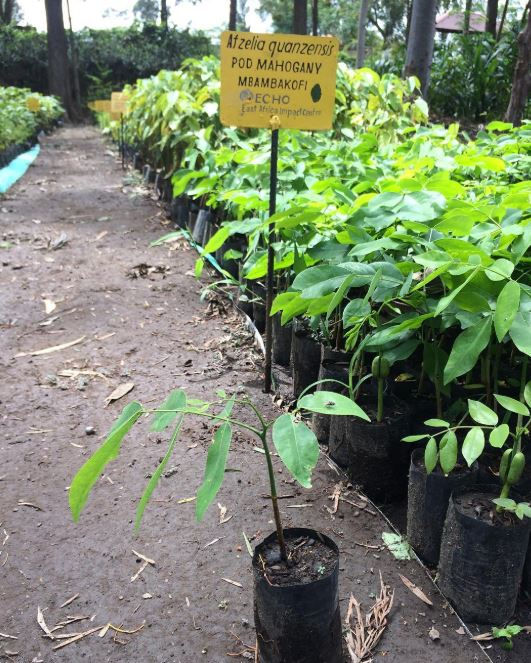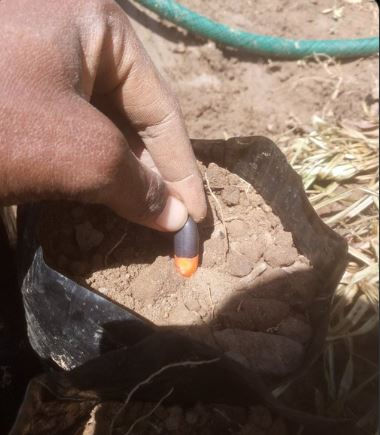Afzelia quanzensis (Pod Mahogany): The African Timber Giant - Uses, Benefits & Conservation
- BeyondForest

- May 6
- 7 min read
Updated: Jun 5

Pod Mahogany Poem
Pod Mahogany, scientifically known as Afzelia quanzensis or the lucky bean tree is a valuable hardwood tree native to Eastern and Southern Africa. It belongs to the Fabaceae family (legume family) and is sometimes referred to as Rhodesian Mahogany or African Mahogany.
Pod Mahogany Seeds germinate at about 2-3 weeks and can be transplanted after they have 2 leaves

the pod mahogany (Afzelia quanzensis) can grow up to 35 metres & provides a feast for hornbills.
This deciduous tree is widely recognized for its durable timber, shade canopy, and ornamental value, making it a popular choice in landscaping, reforestation, and timber industries. Mature trees typically grow between 12 to 20 meters, though they can reach up to 30 meters under ideal conditions. The crown is rounded and wide-spreading, providing excellent shade.

Pod Mahogany produces fragrant, reddish to orange flowers, which are often visited by bees and other pollinators. Flowering generally occurs at the end of the dry season.The tree produces large, woody seed pods, each containing several black seeds with a bright orange aril (a fleshy covering). These pods are a distinctive feature and contribute to the common name "Pod Mahogany."

Pod Mahogany thrives in savanna woodlands, open forests, and well-drained soils. It is drought-resistant once established and prefers sunny locations. It is commonly found in countries like Kenya, Tanzania, Mozambique, Zimbabwe, and South Africa.

In English Language it is referred to as Pod Mahogany ,In Zimbabwe and Zambia it is referred to as Rhodesian Mahogany or Mukwa. In Africa it is broadly referred to as African Mahogany .In Swahili mostly Kenya and Tanzania it is referred to as Mkongo

The name "Pod Mahogany" comes from the tree's large, woody seed pods and its resemblance to true mahogany in timber quality.

Image of a Pod Mahogany Tree by Echo East Africa On IG
,In Mozambique it is referred to as Chanfuta In swahili-speaking regions it is referred to as Mbambakofi .In swaziland it is referred to as Bhunu's Tree. In Giriama Language it is referred to as Mwamba, In Pokomo Language it is referred to as mbambakomfie

Image of a Carved wood of Pod Mahogany by bumblebeecrafts02
Pod Mahogany is not a "true mahogany" (which belongs to the Swietenia genus), but its timber is of comparable quality, hence the name "African Mahogany."

Timber
The heartwood of Pod Mahogany is reddish-brown, heavy, and termite-resistant, making it ideal for: High-end furniture Flooring Boat building Doors and window frames Carvings and crafts . The Pod Mahogany is used to make Oman- Inspired intricately curved doors.

Ornamental Use
Due to its attractive foliage and broad shade canopy, it is planted along avenues, parks, and homesteads.
Medicinal Use
Traditional healers sometimes use the bark and leaves to treat ailments such as fever, wounds, and stomach issues.

Due to overharvesting for its valuable timber, Pod Mahogany is becoming scarce in some areas. In many countries, harvesting is regulated, and sustainable forestry practices are encouraged.


Image of a Pillar Table Made from salvaged Pod Mahogany by Fecit Furniture
What is pod mahogany used for?
Pod Mahogany (Afzelia quanzensis) is primarily used for its high-quality hardwood, valued in furniture making, flooring, boat building, and decorative carvings due to its durability, termite resistance, and attractive reddish-brown color. Its timber is often compared to true mahogany. The tree is also planted ornamentally in landscapes for shade and beauty, thanks to its wide canopy and bright flowers. In traditional medicine, parts of the tree are used to treat wounds, fevers, and digestive issues. Additionally, it plays an ecological role by preventing soil erosion and supporting pollinators and wildlife in savanna and forest ecosystems.

Image of a Large Pod Mahogany Tree in Salamanga, Mozambique by Beat and Bloom
Germinating Pod Mahogany (Afzelia quanzensis) seeds requires careful preparation because the seeds have a hard seed coat, which naturally slows down germination.

Image of ZaizBwoi Planting Pod Mahogany
Seed Collection
Harvest mature pods directly from the tree or collect freshly fallen pods. Let the pods dry and split open naturally to release the seeds. The seeds are hard, black, and covered partly with an orange aril.
Seed Selection
Choose healthy, undamaged seeds. Discard any that are cracked, shriveled, or infested.
Pre-treatment -Scarification
Pod Mahogany seeds are physically dormant, so they need pre-treatment to encourage water absorption:
Mechanical Scarification
Use sandpaper or gently nick the seed coat with a sharp knife (without damaging the inner seed).
Hot Water Soaking
Alternatively, pour boiled water over the seeds, let them soak for 12–24 hours. This softens the seed coat.
Sowing the Seeds
Prepare a seedling tray or pots with well-draining, sandy loam soil or a mix of compost and river sand. Sow the seeds about 2–3 cm deep, with the scarred side facing down. Water lightly but regularly to keep the soil moist (not soggy).
Germination Period
Germination typically occurs within 10–21 days after sowing if conditions are optimal.
Sunlight & Temperature
Place the pots in a warm, partially shaded area. Ideal temperatures are 20–30°C (68–86°F). Avoid exposing young seedlings to full sun or heavy rains in the early stages.
Transplanting
When seedlings are 15–20 cm tall and have 2–3 true leaves, transplant them to larger containers or a nursery bed. Harden them off before final field planting.
Final Planting:
After 4–6 months, transplant into the field during the rainy season. Ensure spacing of at least 4–6 meters between trees to allow full canopy development.
Traditional Medicine
Various parts of the tree are used in ethnomedicine bark decoctions are taken to treat fevers, malaria, and stomach problems. Leaf infusions are used for coughs, colds, and respiratory issues. Crushed bark or leaf paste is applied to wounds and skin infections to promote healing. Some communities chew bark for toothache relief or use it as a mouth rinse. The tree is believed to possess anti-inflammatory, antimicrobial, and antiseptic properties
What is Afzelia Quanzensis used for in medicine?
Afzelia quanzensis, commonly known as Pod Mahogany, has various traditional medicinal uses across Africa. While not widely studied in modern clinical settings, many communities use different parts of the tree including the bark, leaves, and seeds in ethnobotanical medicine to treat several health conditions. While Afzelia quanzensis has a rich tradition in herbal medicine, scientific research on its active compounds, safety, and efficacy is still limited.

In downtown Ndola, there is a national monument called the Slave Tree.

Image of a Pod Mahogany by Zambia A Beautiful Country
The Slave Tree was a large pod mahogany or mupapa tree (Afzelia quanzensis) that was a meeting place for slave traders coming and going from central Africa. Swahili slave traders erected a stockade here under the tree, and the tree provided a shaded meeting area within the stockade. Councils of war were held under the tree and groups of captives from the surrounding population were occasionally sold there during the mid-1800s. The Slave Tree is represented on Ndola’s coat of arms.

The original mupapa tree fell over in 2007, most likely due to termites and weaknesses from the parasitic figs that had been growing on it. However, there is still a plaque that marks the area and the fig has taken over and is flourishing. The plaque reads: ‘This plate has been placed on this mupapa tree to commemorate the passing of the days when, under its shade, the last of the Swahili traders, who warred upon and enslaved the people of the surrounding country, used to celebrate their victories and share out their spoils.’
A few years ago a fence was erected around the remaining fig tree to protect the site. While well-meaning, the key to the fence has been lost and now it is very difficult to read the plaque and information at the site (unless you are small enough to fit through the bars).The monument is open at all times, and is located at the end of Makoli Avenue in central Ndola.
Pod Mahogany Folkore
King Bhunu’s Site of The Hearing

Image of a Monument by eswatini_tourism
This historical plot is opposite the Manzini Library, below LaMvelase Clinic. On the Plot is a Pod Mahogany Tree – commonly referred to as Bhunu’s Tree. It is no surprise that the Mall, not too far from the plot is called Bhunu Mall and its logo is that of a Pod Mahogany.

Image of a Large Pod Mahogany In SwaziLand By eswatini_tourism
History states that on 21st May 1898, a hearing was conducted on the site and a trial later held on 5th September 1898. The hearing was in reference to the killing of Mbhabha Sibandze. On the day of the hearing Bhunu was flanked by Swazi Regiments that showed support for their King. This is the only site that has been legally declared to be of historical significance in Manzini.

Image of Pod Mahogany Leaves by ExtreemTreezz
The mall's presence contributes to the preservation and promotion of Swazi culture, ensuring that the legacy of King Bhunu and the significance of the site continue to be cherished by future generations.
Pod Mahogany Poem
A Pod Mahogany poem by safeguideAfrika
Browsers have trimmed you to chocolate box
prettiness; necklace hunters have tidied
your shade; a lingering damp has put socks
on your naked roots; photographs have fixed
you. Yet still you conjure up the full range
of vertical symbolism, the three
levels of the cosmos; the cyclical

Image of a Pod Mahogany Tree Canopy by safeguideAfrika
nature of life and death. You are a tree
growing in the centre of the world. Will
not emperors climb up and down your trunk?
And Christ: per crucem ad lucem: that strange,
good fruit, did he not die into life? Monk,
monkey, poet, boomslang, crimson-breasted shrike –
of the Umkamba – acolytes alike - John Eppel





Comments